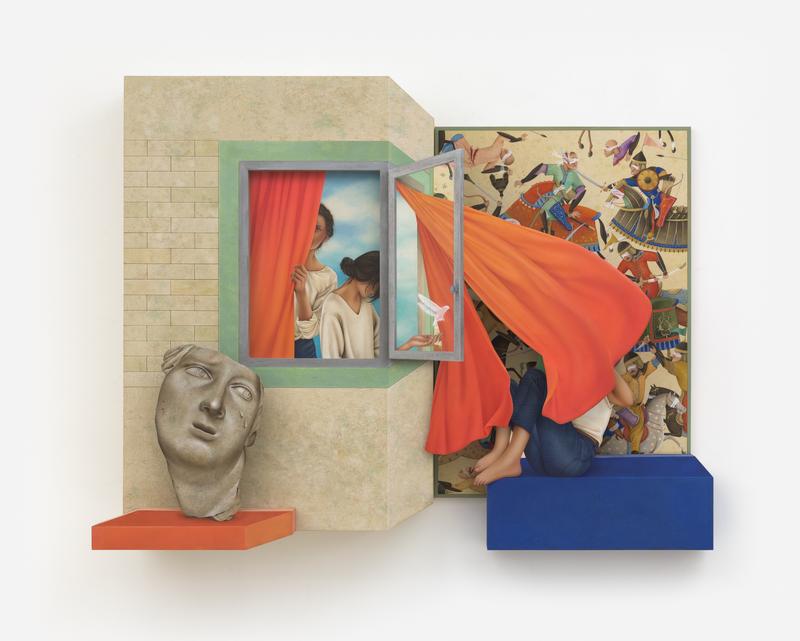Iranian Artist Arghavan Khosravi's New Gallery Show

( Image courtesy of the artist and Rachel Uffner Gallery )
Alison Stewart: This is All Of It on WNYC. I'm Alison Stewart. Artist Arghavan Khosravi's solo show tells the story of Iranian women persevering in the face of oppression through large sculptural paintings divided between two rooms. There are narrative works mounted on the wall that are five feet wide and five feet tall. There are also sculptures telling the story of a legendary Iranian prince, a symbol of innocence and purity, but in this interpretation, it's a woman falsely accused of sexual misconduct and other crimes instead. This exhibition is called True to Self.
Her work is in part a response to the protests following the death of a 22-year-old woman while in Iranian police custody last year. She was arrested for allegedly wearing her headscarf too loosely. True to Self is on display at the Rachel Uffner Gallery at 171 Suffolk Street, and that is through January 6th, so there's plenty of time to see it. Arghavan also has an eponymous exhibition at the Newport Art Museum in Rhode Island. Arghavan Khosravi joins us to discuss. Thank you for coming on the show. Nice to meet you.
Arghavan Khosravi: Hi. Thank you for having me. Nice to meet you too.
Alison Stewart: When you began your work, what did you find yourself exploring with regard to womanhood and autonomy in this show?
Arghavan Khosravi: This show is the continuation of my previous body of work which started a few years ago. It actually started with my childhood memories from Iran and then I moved on and started thinking about what's going on in Iran and my more recent memories. I left Iran in 2015 and have followed the events since then. The more I thought about these memories, the situation of women in Iran was very prominent in my mind. It made me very angry. I wanted to channel this anger in my studio. I started reflecting on those memories and channeling them in my work. My work became more about these women protagonists. Since last year, the role of these women became more and more prominent and they have a stronger presence than before. That's the journey.
Alison Stewart: How did you think about scale and size in this work? Why did you choose the scale that you did? I mentioned the size of some of the work.
Arghavan Khosravi: I wanted to give a very strong presence to these women that are in these sculptures so that these are hard to ignore. I thought that this larger-than-life scale of the portraits and the figures gives this sense of a strong presence. That was the first thing that I had in my mind. I also like to go back and forth in terms of scale in my studio. Have smaller pieces and then make more larger pieces that dictate the space. That was also another reason. In some of these works, I have references to Persian miniature paintings which have a very small, intimate scale. I thought that subverting that tradition while keeping some of the characteristics of those works would be interesting to have.
Alison Stewart: My guest is Arghavan Khosravi. The name of the exhibition is True to Self. It's at the Rachel Uffner Gallery through January 6th, 2024. Before we talk about some specific works, tell me about the choice of the title, True to Self.
Arghavan Khosravi: That was actually title of one of the works in this exhibition that for me it was like an embodiment of the whole show, which includes a woman protagonist in front of a mirror. In one side you see her eyes closed, and then when you look at the mirror, you see the reflection of the other side of that sculptural piece, and you see that she's staring back at you. That was where the title came from, from this piece.
Alison Stewart: Let's talk about a few different pieces in the show as well as that one. The Battleground 2022 is a woman standing with her hands wrapped in black threads. Her hands are behind her back and that extend to this castle structure. Then there are male soldiers painted on her sleeve which are in that miniature, the versions that you mentioned, the very, very small. Where did the inspiration to include the soldiers in the artwork come from? Very small on the sleeves of her dress.
Arghavan Khosravi: Often, I have these battlefield scenes that I appropriate from Persian miniature paintings in my work. This work, I made it prior to the last year's events in Iran. By these soldiers that have a smaller scale compared to the female characters, I'm thinking of attacking women not in a literal sense, but more as a symbol of patriarchy or misogyny depending on how you want to interpret it. That was where these soldiers came from. They're wearing traditional clothes. It also hints that they're stuck in tradition. Patriarchy is something that you face in more traditional societies more often.
That's where they came from. They have a smaller presence compared to the female characters in the work. They're as if they have less importance. The other thing that I want to add is that, these Persian miniature paintings that I'm inspired by in them, women have a less prominent presence. They lack agency. They are either absent or they are in secondary roles. In my work, I also wanted to subvert that notion too.
Alison Stewart: I'm so glad you mentioned that because I was going to ask you, I know it's a very basic question, but to tell us a little bit of the history of the Persian miniature paintings.
Arghavan Khosravi: The Persian miniature paintings were always mostly painted to be part of a book. They had this sense of narrative and they were always depicting a story. That's why their scale is very small. They were usually made by a pattern which was mostly the court. They would hire a group of artists. Each work usually is made by a group of artists. Each artist paints some specific parts. Like today, movie productions which each person is responsible for a specific part in making that final product. That's a very brief history about the Persian miniature paintings. What really fascinates me about these works is the sense of color, how the space is flattened. There's no perspectival depth the way we know it. I can talk on and on about my fascination with these historic works.
Alison Stewart: My guest is Arghavan Khosravi. The name of the exhibition is True to Self at the Rachel Uffner Gallery on Suffolk Street. There's a piece called Orange Curtain from 2022, and it's mounted on the wall of the gallery. It features a woman and a young girl. They could be mother and daughter. There's this orange curtain in the window. The girl has her head down and holding a dove. The woman looks like she's peeking out from behind the curtain. Then there's another woman outside the window who is completely covered by the curtain except for her feet. Then there were soldiers and horses and battle behind her. What is the story of this particular piece?
Arghavan Khosravi: The point of the portrait for this piece for me was this double life that in Iran we live. I think if you talk to any Iranian, they will talk about this separation between the public life and the private life you have. In public, you have to adhere to some regulations, to these Islamic regulations that is imposed by the government. Like the case of Mahsa Amini, you just mentioned. Then in private, you have the liberty to do whatever you want, to think freely. For me, something that separates these two spaces is curtain. You can cover the windows and have the safety of your home behind the curtains.
That is something that I have. It's an element that is recurring in my work like this piece. In this piece what I did is that I subverted this idea of outside and inside. Inside you see, as you described, these two women behind a curtain, but you see sky with clouds behind them. It's sort of outside. It gives that contrast and contradiction. Outside there is this battlefield ground that soldiers are attacking each other, attacking the women. As I mentioned earlier, you can have a more symbolic reading to it. Most of the women's faces in this piece are partially covered or totally covered and the only facial expression you can see is through this Roman sculpture that is in front of the window. It's a three-dimensional piece.
There are several layers and there is a moment that if you look at it from the frontal view, you don't see but the woman who is behind the curtain is actually reading a book. I like to have that revealing moment for the audience so that they move around and find out something that at first glance they didn't see. By reading again, you can have a symbolic and metaphoric interpretation, like knowledge which is something-- by that, you can stand up against the tyranny or the oppressor.
Alison Stewart: It's so interesting that they're multidimensional, your works. This is a silly question but how does that work? [laughs] Where does one start when you're using depth and space like that, to your point, when you look to the side, you get to see something extra in that painting?
Arghavan Khosravi: First of all, I really like to be challenged in the studio. Just making only 2D paintings was not for me, would start being boring. I like to have these challenges and I'm more creative when I'm in a problem-solving mode. I always want to push my studio practice further and three-dimensionality was one way to do it. Also, as you mentioned, I like how the pieces are different depending from what angle you look at them and you can move around them and explore the paintings on your own, something that you cannot capture in a 2D reproduction which is another interesting thing.
I mentioned that this flatness in miniature paintings that most of these works are inspired from is something that I wanted to subvert my work so that this three-dimensionality and depth help to do that. Also, I like to create a 3D space or incorporate a 3D object in my work and then paint a 2D surface which mimics three-dimensionality and juxtapose them side by side. This contrast, I hope that invites the viewer to look closer to figure out which part is painted and which part is the actual 3D space or object.
Alison Stewart: You use a lot of different materials as plexiglass and metal and brass and even really feathers since you like a challenge. What is the most challenging material you've worked with?
Arghavan Khosravi: I think plexiglass because it's not forgiving. If you scratch the surface or make a mistake, you cannot undo it. Also because I fabricate everything myself, cutting plexiglass is more challenging because if you make a mistake, you cannot sand it or use different materials to cover that. It's unforgiving which makes it hard to work with.
Alison Stewart: That is a challenge for sure. My guest is Arghavan Khosravi. The name of the exhibition is True to Self. It's at the Rachel Uffner Gallery until January 6th. You've been inspired by Woman, Life, Freedom, a global movement in solidarity with Iranian women and girls who peacefully demonstrate for their fundamental human rights. What would you want someone to know about this movement and about this organization?
Arghavan Khosravi: To be honest, the purpose of my paintings was not to give something like a message which I want the audience to take this from my paintings. Organically, I couldn't react to what was going on in Iran in my studio. I hope that these pieces convey this sense of strength that Iranian women have and how they are-- There is this notion mostly portrayed by the Western media that Middle Eastern women are victimized and there's a need that someone goes and rescues them. I want to show that they have this powerful presence and they can stand up against the oppression. That was the main--
Also, I wanted to shy away from this stereotypical imagery that you see women wearing hijab. This orientalist approach that you can have about women coming from that region and more specifically Iran. That was the other thing. That's why the figures are wearing contemporary Western clothes. They're not covering their hair because that's the reality of most of Iranian women when they are in the liberty of their private spaces.
Alison Stewart: Please correct me if I'm wrong but you've had your own encounters with Iranian authorities when you were temporarily detained in 2011. What happened?
Arghavan Khosravi: I was arrested by the same morality police back in 2011. I should add that they arrest so many people that it was not something-- You could talk to--
Alison Stewart: A lot of people [crosstalk]
Arghavan Khosravi: They were all Iranian women because they're everywhere on the streets. It was not something that is-- For me, at the beginning it was a shocking experience because I thought I'm wearing proper clothes based on their standards but still, I got arrested and I was held in actually the same police station that Mahsa Amini was murdered. I had to call my family to bring proper clothes so that I could be released and sign something that, "I promise I won't do this again." I had the same experience and unfortunately, a lot of Iranian women have same stories, same experiences. Mine was the least horrible thing that happened compared to what I witnessed on the news.
Alison Stewart: In our last minute, tell us a little bit about the show that's up in Newport at the Newport Art Museum in Rhode Island.
Arghavan Khosravi: This is a solo exhibition that includes about 20 pieces that I have made throughout the last five years. This is the second time that I'm showing at the Newport Art Museum. The first time, it was right after I graduated from Rhode Island School of Design, and I was included in a group show. Now it feels very good to go back to Rhode Island with a solo museum show at Newport Art Museum. It will be up until May.
Alison Stewart: For people in New York who go to see at the Rachel Uffner Gallery, what's one piece you'd like them to spend an extra 10 seconds in front of?
Arghavan Khosravi: That's a tough question. I want all the pieces to be noticed similarly. I really cannot tell.
Alison Stewart: That's okay.
Arghavan Khosravi: I prefer to leave it to the audience because based on their own backgrounds, they might feel more drawn to one specific piece. I prefer not to point out one piece out of all nine of them.
Alison Stewart: Totally fair. The name of the exhibition is True to Self. It's at the Rachel Uffner Gallery on Suffolk Street. My guest has been Arghavan Khosravi. Her show is also at the Newport Art Museum in Rhode Island through May 5th, 2024 if anyone's up for a road trip. Thank you so much for being with us.
Arghavan Khosravi: Thank you for having me. It was a pleasure talking with you and sharing my story.
Copyright © 2023 New York Public Radio. All rights reserved. Visit our website terms of use at www.wnyc.org for further information.
New York Public Radio transcripts are created on a rush deadline, often by contractors. This text may not be in its final form and may be updated or revised in the future. Accuracy and availability may vary. The authoritative record of New York Public Radio’s programming is the audio record.

